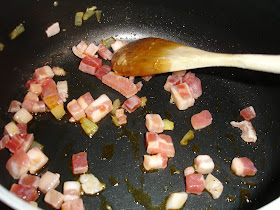Cocido is a dish I have enjoyed at lunchtime when visiting Spain. I have had it in Madrid and down in the south in Granada province, Andalucia. It is one of the really key Spanish dishes, cooked with love over several hours and served up to a hungry family for sustenance, comfort and satisfaction. It is a perfect example of how what is often regarded as 'peasant food' can be some of the tastiest dishes in the world.
The ingredients of Cocido can vary. I've had it with tripe and without it. But it always has pork, either in the form of pork belly, trotters or the bones. It also usually has Chorizo to impart its paprika and fats to the gravy of the dish. I did not realise this until I researched it further, that Cocido can feature meatballs, blood sausage (morcilla), potatoes and carrots.
The traditional way of serving Cocido is in 3 servings. The first being gravy and noodles (fideo pasta), the second being the vegetables and the 3rd being meat.
Personally, having had it served up in a single dish with a little pasta at the bottom and crusty bread to the side, I don't have the inclination to go for the 3 servings. Just the one with these accompaniments is divine!
Please note this recipe is based on my technique for making Cocido using an electric slow cooker. If you do not have one, I set out how to make it in the oven below, but have not tested the method.
I have heard of this dish being made in a Dutch pot/Dutch oven, but have not tried this method myself, not being in possession of such a pot. You will find the recipe, which is quite different from mine here:
Serves 4
Ingredients:
2 onions finely chopped
125g Chorizo finely sliced
65g Cubetti di Pancetta (or up to 80g if your packet is larger)
400g pork belly slices, cut into 1” chunks
8 chicken thighs/drumsticks or mix of both
100g chick peas, soaked overnight, then boiled for 15 minutes and drained
2 tomatoes finely chopped
3 cloves garlic, crushed or very finely chopped
4-5 sprigs fresh thyme
2 sprigs fresh rosemary
3 bay leaves
pinch of saffron soaked in half a mug of hot (not boiling) water
1 litre vegetable/chicken stock
3-4 tbsp olive oil
A couple of handfuls of fideo pasta or capelli corte or other very small pasta shape
Fry onion for 5 mins in the olive oil to start softening them.
Then add the garlic and Chorizo, and fry, stirring frequently for another 5 minutes. The paprika will start seeping out of the Chorizo, colouring the oil reddy-orange; this is a good thing, so don't worry about this. It will add colour and flavour to the final dish.
Remove to a plate, trying to keep the reddy-orange oil in the pan for the next stages.
Next, fry the Pancetta until coloured, about 5 mins. Remove from the pan. Put with the other cooked ingredients.
By this time the pan will have a good flavour base, time to seal the chicken so the skin is beginning to go golden brown. Remove to a different plate.
Now return the onion, garlic, Pancetta and Chorizo to the pan. Add the tomatoes and herbs, and cook for 5 minutes – to get the flavours to combine and to start breaking down the tomatoes.
Add the saffron and hot water and mix, and then add the chicken and pork. Mix well, and add the chick peas. Pour the stock all over.
I cooked my Cocido in a slow cooker, meaning I gave it 8 hours on the slow cooker after the above steps were taken.
You may not have a slow cooker, or want the fuss. In which case you can always use a cast iron casserole dish for the above steps, and then put in the oven at perhaps 160 to 170°C for the remaining cooking. It will need at least 2 hours. Please note that raw soaked chick peas may not cook in this time, so you may want to used tinned instead.
Just when the Cocido is nearly ready, put a small pan of water on the hob for the pasta. As I said above, the authentic accompaniment is fideo pasta. However, I couldn't find this, so I used capelli corte (short cut angel hair pasta) which was a good substitute. Cook until al dente, then drain.
Put the pasta into the bottom of your serving bowl.
Then serve the gravy with a good mix of the other ingredients and crusty bread on the side.












No comments:
Post a Comment